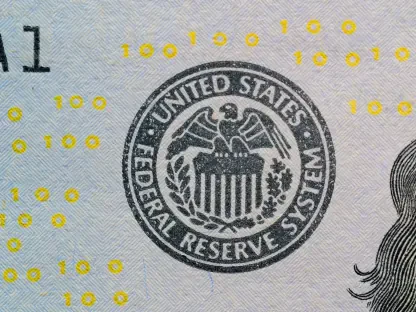The recent dynamics in bond markets have ushered in a wave of discussions about the direction of U.S. monetary policy, with Treasury Secretary Scott Bessent’s comments on bond yields adding fervor to the debate. Currently, a noticeable gap exists between the two-year Treasury yield and the Federal Reserve’s effective funds rate. This anomaly has fueled arguments for interest rate cuts. As of now, the two-year Treasury yield stands at 3.56%, falling below the Federal Reserve’s benchmark rate of 4.33%. This persistent discrepancy, dating back several months, underscores the administration’s argument for reducing rates to ease borrowing costs and stimulate economic growth.
President Donald Trump has taken an active role in advocating for interest rate cuts, often expressing his views publicly and directly engaging with the Federal Reserve’s leadership. Trump has been particularly vocal in criticizing Jerome Powell, the Federal Reserve Chairman, suggesting that his own understanding of U.S. monetary policy surpasses that of Powell. Despite his strong language, Trump has pulled back from removing Powell, recognizing the potential market disruption such actions could cause. His calls for rate reductions come during a period marked by concerns over inflation and economic deceleration, positioning the Federal Reserve’s approach against a backdrop of cautious policy assessment.
Analyzing Bond Yields and Treasury Market Trends
Two-Year Treasury Yields and Market Expectations
In the midst of this ongoing discussion, the two-year Treasury yield has emerged as a critical indicator of market sentiments. It offers insights into anticipated monetary policy changes, particularly regarding interest rate trajectories. The current rate of 3.56% being lower than the Federal Reserve’s effective rate signals that markets are pricing in potential rate cuts. This situation reflects traders’ expectations of the central bank acting to lower borrowing costs to counteract economic slowing.
The administration has seized upon these signals, advocating for rate cuts as a means to stimulate the economy. However, the bond market’s movements are influenced by a complex web of factors beyond domestic monetary policy predictions. These include international investor sentiments and the global economic climate, which are often subject to rapid and unpredictable changes.
Volatility in Treasury Holdings
Further complicating the bond market narrative, recent volatility trends in the 10-year Treasury yield have captured the White House’s attention as a health barometer for the economy. Such volatility often arises when major Wall Street entities adjust their holdings, which recently led to significant fluctuations. Bessent suggests this volatility might be alleviated by the administration’s policies, ultimately aiding in controlling inflationary pressures.
However, financial analysts caution that these fluctuations could also indicate foreign investors’ skepticism about the stability of U.S. Treasurys. Concerns about America’s trade policies and the broader economic trajectory might make investors wary, potentially influencing their decisions in global capital markets. These apprehensions reflect a broader unease about the long-term reliability of Treasurys as secure investments amidst fluctuating geopolitical landscapes.
The Federal Reserve’s Strategic Approaches and External Pressures
Political Pressures for Rate Adjustments
As political pressures mount, the Federal Reserve faces increasing scrutiny. While officials advocate for more accommodative monetary policies, the Fed’s cautious stance reflects broader economic uncertainties. A scheduled policy meeting, set to convene soon, comes amid speculation over possible changes in the Fed’s approach to rates. Yet, observers remain skeptical that the Fed will swiftly implement cuts, especially given the myriad of factors influencing current economic conditions.
The divergence between political advocacy and the Fed’s strategy underscores the complexities the central bank navigates. Balancing internal policy goals with external pressures requires a measured assessment of economic indicators. The Fed aims to avoid precipitous decisions that could exacerbate existing challenges.
Market Skepticism Amid Federal Decisions
Amidst these debates, market analysts note the persistence of skepticism regarding immediate shifts in the Federal Reserve’s monetary policy framework. The intricate interplay between global geopolitical developments and domestic economic signals complicates the decisions before the Federal Reserve. Thus, many investors remain cautious, adopting a wait-and-see approach until clear signals from economic data justify a specific course of action.
The Fed’s strategy reflects its commitment to safeguarding economic stability while being aware of potential market overreactions. By maintaining a data-driven approach, the Federal Reserve seeks to steer the economy through uncertain times, even as political narratives call for more aggressive interventions.
Conclusion: Navigating Complex Economic Landscapes
The current shifts in bond markets have sparked intense debates over U.S. monetary policy, driven partly by Treasury Secretary Scott Bessent’s remarks on bond yields. A significant discrepancy exists between the two-year Treasury yield and the Federal Reserve’s effective funds rate, fueling arguments in favor of cutting interest rates. Presently, the two-year Treasury yield is at 3.56%, below the Federal Reserve’s 4.33% benchmark rate. This ongoing gap emphasizes the administration’s stance that lowering rates could reduce borrowing costs and boost economic growth.
President Donald Trump plays a pivotal role in advocating for interest rate cuts, frequently expressing his opinions publicly and actively engaging with the Federal Reserve’s leadership. He has openly criticized Chairman Jerome Powell, suggesting his understanding of monetary policy surpasses Powell’s. While he has criticized Powell, Trump refrains from removing him to avoid market volatility. His push for rate cuts occurs amid inflation concerns and slowing economic momentum, placing the Fed’s cautious policy approach under scrutiny.









